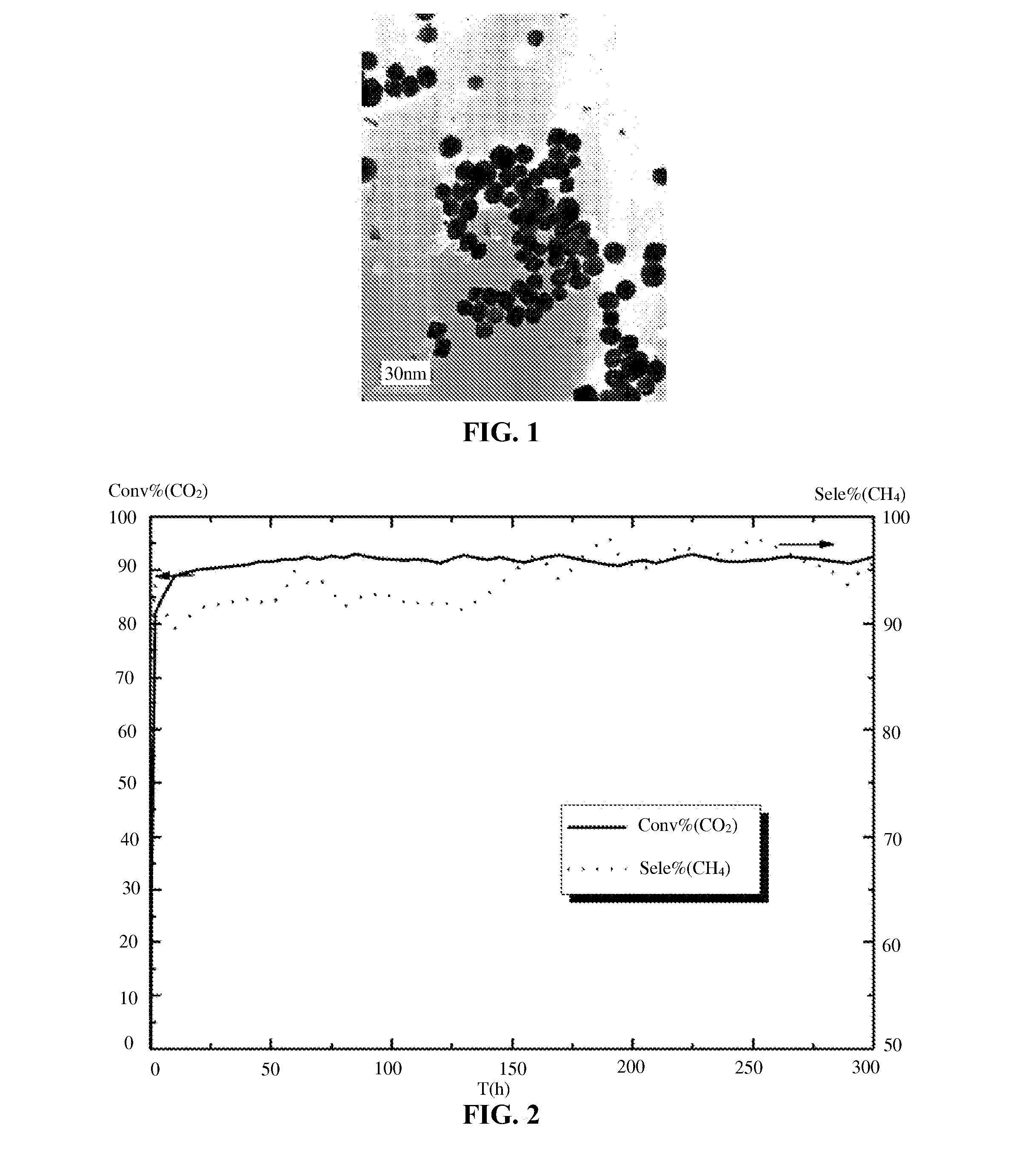Liquid catalyst for methanation of carbon dioxide
a liquid catalyst and carbon dioxide technology, applied in the direction of organic compounds/hydrides/coordination complexes catalysts, metal/metal-oxide/metal-hydroxide catalysts, etc., can solve the problems of limiting the application of cosub>2 /sub>methanation catalysts, reducing the activity of catalysts prepared by conventional methods, and coagulation of metal active nanoparticles. , to achieve the effect of facilitating co2 to ad
- Summary
- Abstract
- Description
- Claims
- Application Information
AI Technical Summary
Benefits of technology
Problems solved by technology
Method used
Image
Examples
example 1
[0029]Nickel nitrate, magnesium nitrate, and an ionic liquid of 1-hexadecyl-3-methylimidazole hydrochloride were mixed according to a molar ratio thereof of 1:0.2:20 and dispersed in a liquid medium, for example, water, to yield a mixed solution. In the mixed solution, the molar concentration of nickel nitrate was 2.79×10−4 mol / L. The pH value of the mixed solution was adjusted using aqueous ammonia to 9.0. The mixed solution was stirred for 3 hours and transferred to a reactor. The reactor was heated to 150° C. and aerated with hydrogen at the pressure of 3.0 MPa for 2 hours. The resulting product was centrifuged, filtered, washed respectively with water and alcohol, and dried. TEM measurement showed that, the nanoparticles of the metal active component of the liquid catalyst for methanation of carbon dioxide had an average particle size of 11.8 nm, with a narrow and uniform distribution.
[0030]The liquid catalyst is applied to methanation of CO2. Specifically, the liquid catalyst a...
example 2
[0031]Nickel acetate, lanthanum nitrate, and an ionic liquid of 1-octadecyl-3-methylimidazole hexafluorophosphate were mixed according to a molar ratio thereof of 1:0.15:20 and dispersed in a liquid medium, for example, alcohol, to yield a mixed solution. In the mixed solution, the molar concentration of nickel acetate was 3.61×10−4 mol / L. The pH value of the mixed solution was adjusted using triethylamine to 8.0. The mixed solution was stirred for 2 hours and transferred to a reactor. The reactor was heated to 100° C. and aerated with hydrogen at the pressure of 3.0 MPa for 1.5 hours. The resulting product was centrifuged, filtered, washed respectively with water and alcohol, and dried.
[0032]The liquid catalyst is applied to methanation of CO2. Specifically, the liquid catalyst and water were added to a reactor. The concentration of the liquid catalyst in the reaction system was controlled at 0.005 mol / L. CO2 and H2 were charged to the reactor according to the equation nH2: nCO2=4,...
example 3
[0033]Nickel nitrate, cerium nitrate, and an ionic liquid of N-dodecyl pyridinium tetrafluoroborate were mixed according to a molar ratio thereof of 1:0.15:18 and dispersed in a liquid medium, for example, acetonitrile, to yield a mixed solution. In the mixed solution, the molar concentration of nickel nitrate was 1.32×10−3 mol / L. The pH value of the mixed solution was adjusted using diisopropyl tert-butylamine to 10.0. The mixed solution was stirred for 3 hours and transferred to a reactor. The reactor was heated to 150° C. and aerated with hydrogen at the pressure of 3.0 MPa for 1.5 hours. The resulting product was centrifuged, filtered, washed, and dried.
[0034]The liquid catalyst is applied to methanation of CO2. Specifically, the liquid catalyst and water were added to a reactor. The concentration of the liquid catalyst in the reaction system was controlled at 0.005 mol / L. CO2 and H2 were charged to the reactor according to the equation nH2: nCO2=4, heated to 120° C., and allowe...
PUM
 Login to View More
Login to View More Abstract
Description
Claims
Application Information
 Login to View More
Login to View More - R&D
- Intellectual Property
- Life Sciences
- Materials
- Tech Scout
- Unparalleled Data Quality
- Higher Quality Content
- 60% Fewer Hallucinations
Browse by: Latest US Patents, China's latest patents, Technical Efficacy Thesaurus, Application Domain, Technology Topic, Popular Technical Reports.
© 2025 PatSnap. All rights reserved.Legal|Privacy policy|Modern Slavery Act Transparency Statement|Sitemap|About US| Contact US: help@patsnap.com

